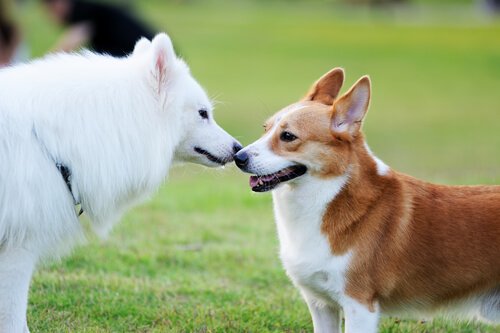How to Make Two Dogs Get Along with Each Other

When you have a dog at home, the desire to adopt another grows every day. Once factor might be that if our animal spends time alone while we are at work or other work, we may want him to have a companion. But how do you make two dogs to get along? In this article we’ll show you how.
Of course, you must keep in mind that it may not be as nice as it seems, because all dogs have their different personalities, so adapting to each other may not be as easy as we thought. What can we do to better the coexistence between several dogs? Here’s some advice about that.
Socialization: Helping dogs get along

Fighting for affection
Both dogs will probably want to have the affection of the owners, so it’s paramount that each one has his space. The dog that is already at home shouldn’t think that someone is invading his home, neither should the new dog feel like an outsider, so follow these simple guidelines:
- Each one must have his own bed. If they want to make friends and sleep together, it’s okay, but don’t force them to do that. You must have a bed for every animal, in different places.
- Different food dishes. The food dishes must also be different, and be in different places. If the animals are different ages, you must also buy different meals for each one.
- Do not give more affection to one than to another. You may be tempted to lean towards the new dog because of it’s new, especially if it’s a puppy. You may want to have it in your arms all the time and get to know it. However, if you give too much attention to the new dog, and relegate your old faithful friend’s status, problems will definitely arise between them.
Dogs should get to know each other in order to get along

On the other hand, it is important that dogs get to know each other before sharing territory. To help them do this you must follow these recommendations:
- Choose a quiet and neutral place. It’s better for dogs to meet each other outside the house, perhaps in a park or on a beach.
- Keep them on a leash. Do not trust them, and keep them leashed so that they can approach slowly and smell each other, and you can pull them back if any problems arise.
- Have them come home together. Once you have seen that everything is going more or less well, let both dogs enter the house together. If you let them in one at a time, the first one will consider himself to be dominant and then the other will see him as an enemy and not as an equal.
- If necessary, enclose the older dog and let the new one walk around the house to inspect it and get used to it.
When you think ahead and are patient, the coexistence between your two friends will be peaceful and quiet and you’ll get the two dogs to get along and love each other.
All cited sources were thoroughly reviewed by our team to ensure their quality, reliability, currency, and validity. The bibliography of this article was considered reliable and of academic or scientific accuracy.
- Dogs Act Jealously Even When They Don’t See Their Rival, Association of Psychological Science. Recogido a 12 de enero de 2022 en https://www.psychologicalscience.org/news/releases/2021-april-dogs-jealous.html
This text is provided for informational purposes only and does not replace consultation with a professional. If in doubt, consult your specialist.